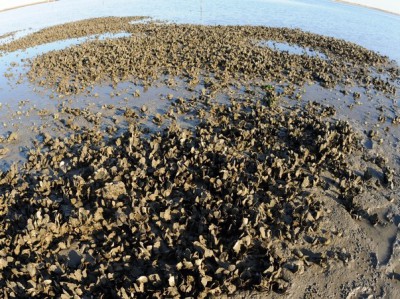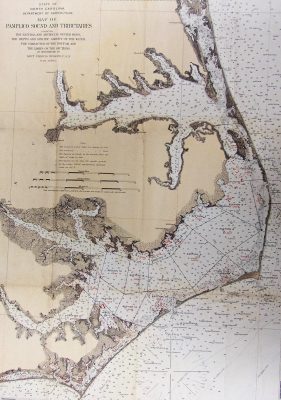Oysters were the hamburger of the 19th century. By the 1880s, an improved transportation network and advances in canning techniques had spread the bivalve into almost every bar, restaurant, home and recipe in the country. They were consumed by everyone, rich and poor alike, and according to one observer, the only difference was whether the oysters were consumed with beer or champagne.

Virginia and Maryland, masters of Chesapeake Bay, were enjoying an unprecedented economic windfall. North Carolina, with extensive oyster beds and reefs, was very much on the outside looking in.
Supporter Spotlight
By 1885, North Carolina’s state legislature had had enough and “… Resolved, That the State Board of Agriculture shall cause to be made a survey of … natural oyster beds and private oyster gardens together with an examination of the waters of the State …”
Legislators also asked “… the Federal Government to detail some person of the public service who is an expert in these matters …”
The federal government sent to the state Navy Lt. Francis Winslow, perhaps the preeminent American “… expert in these matters.”
Winslow had already conducted a survey of Chesapeake Bay for Maryland in 1879, and his conclusions gave a full-throated warning about the future of oyster harvests in the state. Meticulous in his approach, taking a series of detailed and careful measurements, he warned “… the beds are rapidly and surely deteriorating from the excessive fishing …”
His work extended to Europe where he was recognized for his research and discoveries.
Supporter Spotlight

Winslow was the right man at the right time for the job.
In 1887 he published his “Report of the Waters of North Carolina with reference to their Possibilities for Oyster Culture.”
The report is remarkable in its detail and the stark future Winslow foresees. Examining the decline in oyster harvests in France, England and Cape Cod Bay, taking note that a lack of regulation and overfishing caused the stocks to collapse, he wrote, “Reviewing the testimony, there can be no doubt that the beds of North Carolina, if they continue to be exposed to an unrestricted fishery and obtain no measure of relief, will share the universal fate and be destroyed.”
Winslow’s examination of North Carolina’s oyster culture touched on all phases of it. He was harshly critical of the laws of the state, writing the following:
“Summing up the results in the several branches of the inquiry and the information obtained it is evident that:
“The natural beds are deteriorating principally through over fishery and want of intelligent supervision.
“That the area of artificial beds has not been extended in proportion to the demands of the general market nor to the area suitable for cultivation.
“That this want of progress is due to the indefinite description of the areas exempted from entry to the limitation of the oyster farmer to small and inadequate tracts and to the insecurity of titles.”
He pointed out that the methods for marking private oyster beds — gardens as they were called at the time — were haphazard and confusing.
“If the practice of requiring surveys and descriptions giving metes and bounds was uniform throughout the State much trouble and labor would have been saved. But instead of being uniform, it has been just the reverse, each Clerk of Court having a different method of procedure and a different form of application and license.”
He also demonstrated a clear understanding of how decisions made at the state level could affect the most vulnerable.
“To restrict the fishery will in effect deprive many of the poorer class of people of a portion of their subsistence and means of livelihood nor is it necessary except in extreme cases to do so,” Winslow wrote.
But what Winslow is mostly known for are his maps.
Accurate to an extraordinary degree, containing detailed information about the locations of oyster beds and reefs from Roanoke Sound to the Cape Fear River, the maps have been invaluable aides in helping to re-establish oysters in the state.
The maps are so accurate that the reefs Winslow identified can still be found using his coordinates and GPS. Although many of the reefs no longer have oysters clustered on them, evidence that they once were home to thriving oyster colonies still exists and it gives researchers a clear understanding of where to go to seed new beds.
His report was filed with the state Jan. 1, 1887, and to its credit, the state did try to implement some of his recommendations.
The legislature codified a consistent way to survey oyster gardens, an oyster commission was established and some of the rules governing how oysters could be harvested were modernized.
Running Afoul of Locals
Winslow resigned his commission in 1889, after serving 15 years in the Navy. What happened after he resigned his commission is controversial.

He came back to North Carolina and formed the Pamlico Oyster Co. Taking advantage of new state laws that would allow him to lease oyster beds from the state, he planned to harvest oysters off Ocracoke Island.
The locals cried foul.
The oystermen were adamant that the beds the state had leased were family heirlooms and that he had no right to work the beds. They also pointed out that the very areas he was leasing were those that he had indicated could not be fully surveyed because of weather and time constraints.
In his defense, Winslow noted a detailed survey may not be necessary if the right conditions exist. “The farmer can say whether or not a piece of land is good … and the geologist can give information as to possible or probable veins of ore … In the same way it is impossible for anyone to decide positively that oysters can be grown profitably on any particular area … But by studying the various conditions … and through a knowledge of … the life of an oyster … an approximation … may be reached.”
More troubling, perhaps — at least to the Ocracoke oystermen — were the tactics Winslow used to harvest the oysters.
Oystermen at that time were paid 8 cents a tub. A tub was a 19th century container of varying sizes but somewhat less than a bushel. Winslow, who was planning on harvesting much more than had ever been gathered was offering 5 cents a tub.
Rather than pay the higher price, Winslow went to Elizabeth City and hired an African-American crew at the 5 cents a tub rate.
The result was a confrontation that almost ended in violence.
Confronted by five armed Ocracoke Islanders, Winslow and his white foreman brandished their pistols. Both sides claimed self-defense.
The Ocracoke men petitioned then-Gov. Daniel Fowle, claiming the oyster beds had been in their families for generations and that they needed protection from “Lieut. Winslow, his dogs and negroes.”
Winslow swore out a complaint with the Hyde County sheriff. The sheriff claimed there was no way that he could enforce the complaint.
Winslow then petitioned the governor, requisitioning an armada escort to work the oyster beds he had leased from the state.
Walking a political tightrope, the governor refused armed intervention, but he told the oystermen that they would have to seek legal remedy. Fowle went on to say that he acknowledged their belief that working the oyster beds for generations gave them ownership, but that belief may not be sufficient in a court of law.
Winslow never did work the waters that he had leased, and in an angry letter to the governor he accused him of “being in sympathy with law-breakers.”
A year later, during the North Carolina “oyster war,” oyster dredges from Virginia and Maryland invaded Pamlico Sound and Fowle was forced to use the state militia to restore order.







